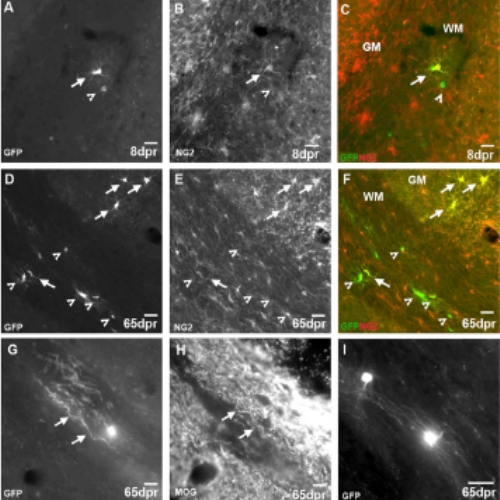- Home ·
- Publications ·
- Research Area F ·
- 2008 ·
Progeny of Olig2-Expressing Progenitors in the Gray and White Matter of the Adult Mouse Cerebral Cortex
01-Oct-2008
Leda Dimou, Christiane Simon, Frank Kirchhoff, Hirohide Takebayashi, Magdalena Götz
The Journal of Neuroscience, 2008, 28(41), 10434–10442, doi:10.1523/JNEUROSCI.2831-08.2008 published on 01.10.2008
The Journal of Neuroscience, online article
The Journal of Neuroscience, online article
Despite their abundance, still little is known about the rather frequent, constantly proliferating progenitors spread throughout the adult mouse brain parenchyma. The majority of these progenitors express the basic-helix-loop-helix transcription factor Olig2, and their number further increases after injury. Here, we examine the progeny of this progenitor population by genetic fate mapping using tamoxifen-inducible Cre-recombination in the Olig2 locus to turn on permanent reporter gene expression in the adult brain. Consistent with Olig2 expression in proliferating NG2+ progenitors, most reporter+ cells seen shortly after initiating recombination at adult stages incorporated BrdU and contained the proteoglycan NG2 in both the gray (GM) and the white matter (WM) of the cerebral cortex. However, at longer time points after induction, we observed profound differences in the identity of reporter+ cells in the WM and GM. Whereas most of the Olig2+ progenitors had generated mature, myelinating oligodendrocytes in the WM, hardly any reporter+ cells showing mature oligodendrocyte characteristics were detectable even up to 6 months after recombination in the GM. In the GM, most reporter+ cells remained NG2+, even after injury, but stopped proliferating rather soon after recombination. Thus, our results demonstrate the continuous generation of mature, myelinating oligodendrocytes in the WM, whereas cells in the GM generated mostly postmitotic NG2+ glia.











